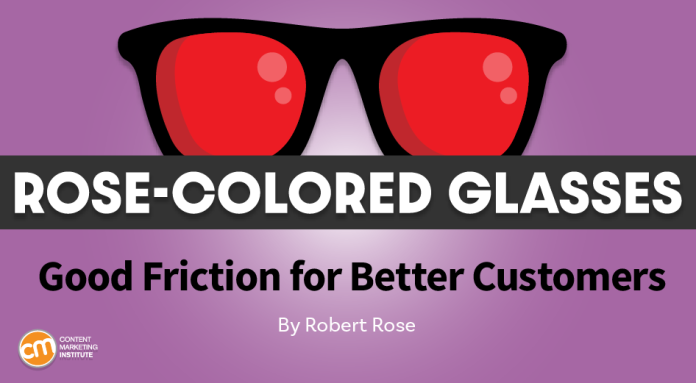“The future is already here – it’s just not evenly distributed yet.”
This fantastic quote, usually attributed to author William Gibson, perfectly captures the state of generative AI and automation in marketing.
As we move toward what will hopefully be a better year, I am optimistic that the benefits of AI will be more evenly distributed.
But I also worry that this could make us forget this crucial truth: the iterative work of strategy and the creative process are inherently fraught with friction. And that friction is valuable.
I think friction also plays an important role in the experiences marketers create for potential buyers and customers.
Let me explain.
The smooth pizza ordering
I ordered Domino's pizza not long ago. Yes I know. But stay with me for a moment.
Remember the scene in Reality Bites where Lelaina, played by Winona Ryder, orders dominoes and asks, “Do they take checks?”
I hadn't ordered Domino's since the movie came out. That's right – it's been almost 30 years.
In the mid-1990s there were no apps, websites or pizza trackers. Instead, someone left a Domino's swipe card on your doorknob and you stuck it to your fridge. When you called to order, the menu was simple: pizza. Big or small. Thick or regular crust. Eleven toppings. Completed.
In 1994, Domino's ordering was all about efficiency. You called, chose your pizza and 30 minutes later it was at your door.
The brand became synonymous with average, efficient pizza.
After several neighbors told me I was missing out, I tried Domino's again. I approached the 2024 experience with my 1994 expectations: average, efficient pizza.
To Domino's credit, the iPhone app did the efficient part.
The menu has grown explosively over the past few decades and now includes chicken, tater tots, sandwiches, pastas, salads, desserts and five-crust pizzas.
The app guided me through the ordering process quickly and painlessly. I picked out a few pizzas and threw in some cheesy Tater Tots (don't judge). The delivery address suggested by the GPS was incredibly accurate. My order was in motion.
Less than 30 minutes later my pizzas and snacks arrived.
What were they like?
Meh. It might be another 30 years before I try again.
When I shared my experience with my neighbors, they were horrified. “You didn’t do it right,” they said. “You have to adjust it and ask for double cheese. Add garlic! And the cheddar bacon tots – they’re awesome.”
I was fascinated. In their eyes, my “meh” experience was my fault. I hadn't taken the time to dive into the endless customization options and curate the optimal experience.
And honestly? They weren't wrong.
But my Domino's experience holds an important lesson for marketers: Friction can be a good thing in complex sales.
Wait. Really?
Isn’t the point of marketing to eliminate friction in the buyer’s journey?
Maybe not.
The “right way” to buy
Over the last 20 years, marketers have been bombarded with the message: eliminate friction.
You've probably implemented technology that promises to “remove friction from the customer journey.” They've optimized websites, pared down product landing pages, and created sales enablement scripts so dense that there's no room for an employee to read the room.
But here's the thing: B2B products and services are inherently complex. Your endless “toppings” and “side dishes” will set you apart and make your solution truly valuable.
Take “Marketing Cloud” and “Marketing Hub” products from HubSpot, Oracle, Salesforce or Adobe. They offer so many options that even I can't tell you all the components within them – and I've spent over a decade analyzing this area.
This complexity presents a major challenge: How can you offer your customers meaningful choices without overwhelming them?
The answer? They create friction – strategic, intentional friction that slows the buyer's journey just enough to add value and improve their overall experience.
I've seen some modern B2B companies nail this approach with one or more of the following approaches.
1. Use content data to add context, not just precision
Most B2B companies collect first-party data to personalize their offers, but they often miss the mark. They focus too much on who the buyer is and gloss over the why or what behind their decisions.
A smarter strategy? Tag your content with attributes that refine and prioritize your recommendations. Highlight unique features or combinations that make the customer stop, slow down and say, “Oh, that’s different than I thought.” That might be exactly what I need.”
2. Feature packs sell better than endless options
I learned this the hard way years ago. As the CMO of a web content management software company, I was proud of our “we can do anything” flexibility for translation and localization workflow features. We thought eliminating objections – any friction – would seal the deal.
It turns out we were wrong. Customers didn’t want a blank sheet of paper. They wanted to know exactly how we would solve translation problems. They wanted to compare methods because their current process wasn't working. Saying “yes, anything you want” didn’t give them confidence that we had a point of view on a solution.
By recommending specific options like “Most customers choose this,” “Recommended for you,” or “Editor’s Choice,” you slow down the decision-making process—but you lead it to better results.
Customers feel supported and not overwhelmed.
3. Transform the “dead zone” into an intervention zone
There is a phase in every B2B buyer’s journey that I call the “dead zone.” It's that awkward gap after the customer says “yes” but before the contract is signed and the solution is delivered, integrated or implemented.
Here's what usually happens: The sales team backs out because they're afraid of rocking the boat while the customer gets nervous. Contracts, delivery and onboarding can make them reconsider their decision before even using the product.
Slowing things down here – adding intentional, valuable friction – can make all the difference. Share thought leadership, helpful resources, or onboarding content that will set them up for success. Instead of silence, give them reasons to feel excited and prepared.
Valuable engagement during this “dead zone” reduces buyer’s remorse and turns new customers into loyal advocates. It's not about upselling; it's about creating trust.
Adding friction isn't about complicating the process, it's about improving results.
Friction can be good
The B2B marketer's job is not to design a buyer's journey so thoroughly that they miss opportunities to pause and rethink. Sometimes this break creates real added value.
Take advantage of my Domino's experience. The app was a marvel of efficiency: identify delivery location, set time, and select items. Pizza? Large. Crust? Thin. Toppings? Pepperoni, onions. Anything else? Tots. Checkout. Completed.
But imagine if the app slowed me down after I selected the first few options. Maybe with a message like: “Wait – most customers in your area swear by double cheese.” Do you want to try it?” Or: “Welcome back! Did you know that this particular combination is currently trending?”
This moment of friction could have made me rethink my decisions and enjoy the experience (and perhaps the pizza) more.
Customers often don't know exactly what they want. Or, worse, their assumptions lead to subpar decisions.
You and your competitors may offer nearly identical products, but the difference lies in how you guide your customers through the decision-making process.
By introducing deliberate pauses, you help customers discover the combinations that make your solution stand out.
As you focus on acquiring more valuable, loyal customers who will stay with you and spread the word about your brand, remember: sometimes it's better to slow down and help them make the right choice than to make them the wrong one to urge.
It's your story. Say it well.
HANDPICKED RELATED CONTENT:
Cover image by Joseph Kalinowski/Content Marketing Institute
https://blog.5gigbucks.com/create-your-very-own-auto-publish-news-blog-site-and-earn-passive-income-in-just-4-easy-steps/

![Like a brand, marketing attribution puzzle solved [Video]](https://blog.5gigbucks.com/wp-content/uploads/2025/03/Like-a-brand-marketing-attribution-puzzle-solved-Video-218x150.png)





